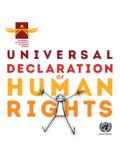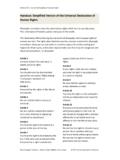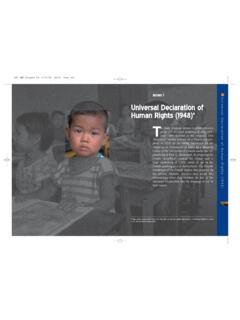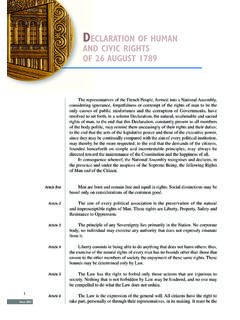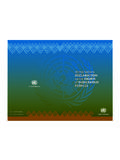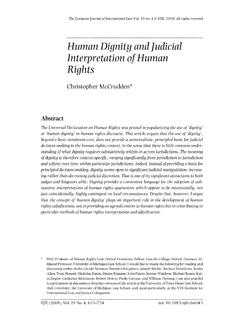Transcription of What Are Human Rights? Lesson I Teacher’s Guide
1 what Are Human rights ? Lesson I teacher s Guide Purpose: To make the student aware of the United Nations universal declaration of Human rights and how it was created. Materials: what Are Human rights ? (booklet) based on the universal declaration of Human rights . Booklet can be found at the back of this YHRI International Youth Summit at the United Nations (DVD) Handouts: Mrs. Roosevelt Said This About Human rights Time: 1. Attention getter 5 m. 2. Clarify key words 10 m. 3. Human rights (read aloud section from what Are Human rights ?) 5 m. 4. Discuss reference 10 m. 5. Eleanor Roosevelt (read section aloud) 2 m. 6. United Nations (read section aloud) 3 m.
2 7. Explain and Show 15 m. Total Time: 50 m. teacher Prep: Read the booklet what are Human rights ? Read the section at the beginning of the booklet, Human rights Reproduce the handout found directly following the Lesson plan. The Mrs. Roosevelt handout can be used as per the Student Challenge (see later) or to give the students as a supplement for the Lesson . Set up DVD player or computer that can play DVD Tips: Go to a nearby library or look on the Internet for simple references on Eleanor Roosevelt and the United Nations. Display the books or printed matter in your classroom. Picture books are best for attractive displays and for inviting your students to explore further.
3 what Are Human rights ? Lesson I Lesson Plan Present each part of the Lesson plan in the following order. Attention Getter (5 min.): Read the following story about a young girl who is a Human rights advocate. Be sure to clarify the word advocate in the first sentence. Before starting, show the students where Tibet and China are on a globe or map. Tell them you will be talking about these two countries. Use this story to attract interest and get the students involved in the Lesson to follow. A Young Girl Teaching Human rights Claire Kevitt is a 14-year-old Human rights advocate (an advocate is a person who supports or speaks in favor of something). Claire is the Youth President of a special group called Youth for Human rights International.
4 She has spoken at important meetings where adults are examining Human rights issues. One time, she and her friends rode their bicycles for five days and many miles all around the big city of Los Angeles, where they live. Along the way, they met with school children, local leaders and journalists (reporters, writers, or editors of news stories for newspapers, magazines, radio and television). Claire and her friends taught the children who they met about Human rights and asked people to sign a pledge of support for Human rights . Claire has spoken to many classrooms full of children, to explain what Human rights are and get young people learning their Human rights . Claire has even traveled to the United Nations in New York (the United Nations is an organization composed of many countries who have agreed to work toward peace and Human rights for all people) to talk with other young people and adults about educational solutions to the Human rights problems facing people around the world.
5 She works on these projects with the help of young members of Youth for Human rights International. Claire started working for Human rights when she was six years old. Her parents took her to a movie called Seven Years in Tibet. It was about the gentle religious leader of Tibet who had to leave his home and his country because of war with its neighbor, China. Claire wanted to find out more about the true story of the leader, who is called The Dalai Lama. She asked her parents to read books to her about the Dalai Lama. Then she wrote the Dalai Lama asking what she could do to help him return to Tibet. Her mother helped her write the letter and the Dalai Lama replied, suggesting she write some more letters to certain leaders and groups.
6 She did what he suggested and was very happy to help him. She s been a Human rights advocate ever since. Does Claire seem different from you? Well, we are all different from each other and that s what makes it so fun to get to know each other. We also have many similarities. Actually, every one of you is capable of helping with Human rights , just as Claire does. Besides Claire s Human rights work, she goes to school, has hobbies, plays sports, goes places with her friends, laughs at silly jokes, plays the piano, and does chores at home. what is remarkable about Claire is that Human rights is very important to her. It is something she thinks about and works on nearly every day.
7 -End of Story- Clarify Vocabulary (10 min.): rights - claims or freedoms to be, do, or have something. His rights are protected by law. Human - having to do with a person or persons. Men, women, and children are Human beings. declaration - the act of announcing or making something known; a document showing that those that signed it are showing their agreement with certain ideas. He signed the declaration yesterday. universal - of, for, or shared by all. The need for food is universal . Read aloud to the students (5 min.): what Are Human rights ? page 2, section titled what are Human rights ? Be sure to clarify, as you go along, any words the students might not understand.
8 Discussion Questions (10 min.): what are Human rights ? Can you give examples? what do Human rights have to do with you? Read aloud to the students (2 min.): Eleanor Roosevelt Eleanor Roosevelt (1884-1962) was the wife of Franklin D. Roosevelt, president of the United States during World War II. World War II began in September 1939 and ended six years later, in September 1945. President Roosevelt died just before the end of the war. Mrs. Roosevelt worked very hard to make things better for people especially young people while her husband was President and she continued her work after he died. When the war was over, Mrs. Roosevelt was asked to join the new United Nations as a delegate (delegate: someone who represents his group at an important meeting or for an important project) from the United States.
9 Mrs. Roosevelt became the main writer of the United Nations universal declaration of Human rights . Read aloud to the students (3 min.): what Are Human rights ?, page 3, section titled About the United Nations universal declaration of Human rights . Explain and Show (5 min.): The United Nations building is located in New York City (show map). The purpose of the United Nations is to work for peace among the nations of the world through communication, peaceful negotiations and betterment of the Human condition through Human rights . Show a picture of the UN (from encyclopedia or internet). Play DVD YHRI International Youth Summit (10 minutes) Student Challenge (Optional): Give the students the handout titled Mrs.
10 Roosevelt Said This About Human rights . Challenge the students to read it and learn by heart this part of the quote, Where, after all, do Human rights begin? In small places close to home so close and so small that they cannot be seen on any maps of the world. This will be a recurring theme throughout these Lesson plans. Ask them to recite this in the next Lesson and when they do, you might want to offer the students who take up this challenge, an extra privilege, sticker, reward or any other small extra treat of some kind that they would appreciate. End of Lesson Lesson I Handout MRS. ROOSEVELT SAID THIS ABOUT Human rights Where, after all, do universal rights begin?
